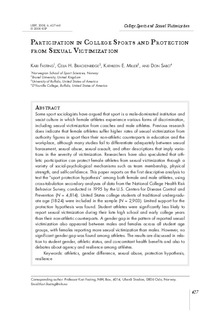| dc.description.abstract | Some sport sociologists have argued that sport is a male-dominated institution and sexist culture in which female athletes experience various forms of discrimination, including sexual victimization from coaches and male athletes. Previous research does indicate that female athletes suffer higher rates of sexual victimization from authority figures in sport than their non-athletic counterparts in education and the workplace, although many studies fail to differentiate adequately between sexual harassment, sexual abuse, sexual assault, and other descriptions that imply variations in the severity of victimization. Researchers have also speculated that athletic participation can protect female athletes from sexual victimization through a variety of social-psychological mechanisms such as team membership, physical strength, and self-confidence. This paper reports on the first descriptive analysis to test the "sport protection hypothesis" among both female and male athletes, using cross-tabulation secondary analyses of data from the National College Health Risk Behavior Survey, conducted in 1995 by the U.S. Centers for Disease Control and Prevention (N = 4,814). United States college students of traditional undergraduate age (18-24) were included in the sample (N = 2,903). Limited support for the protection hypothesis was found. Student athletes were significantly less likely to report sexual victimization during their late high school and early college years than their non-athletic counterparts. A gender gap in the pattern of reported sexual victimization also appeared between males and females across all student age groups, with females reporting more sexual victimization than males. However, no significant gender gap was found among athletes. The results are discussed in relation to student gender, athletic status, and concomitant health benefits and also to debates about agency and resilience among athletes. | en |
